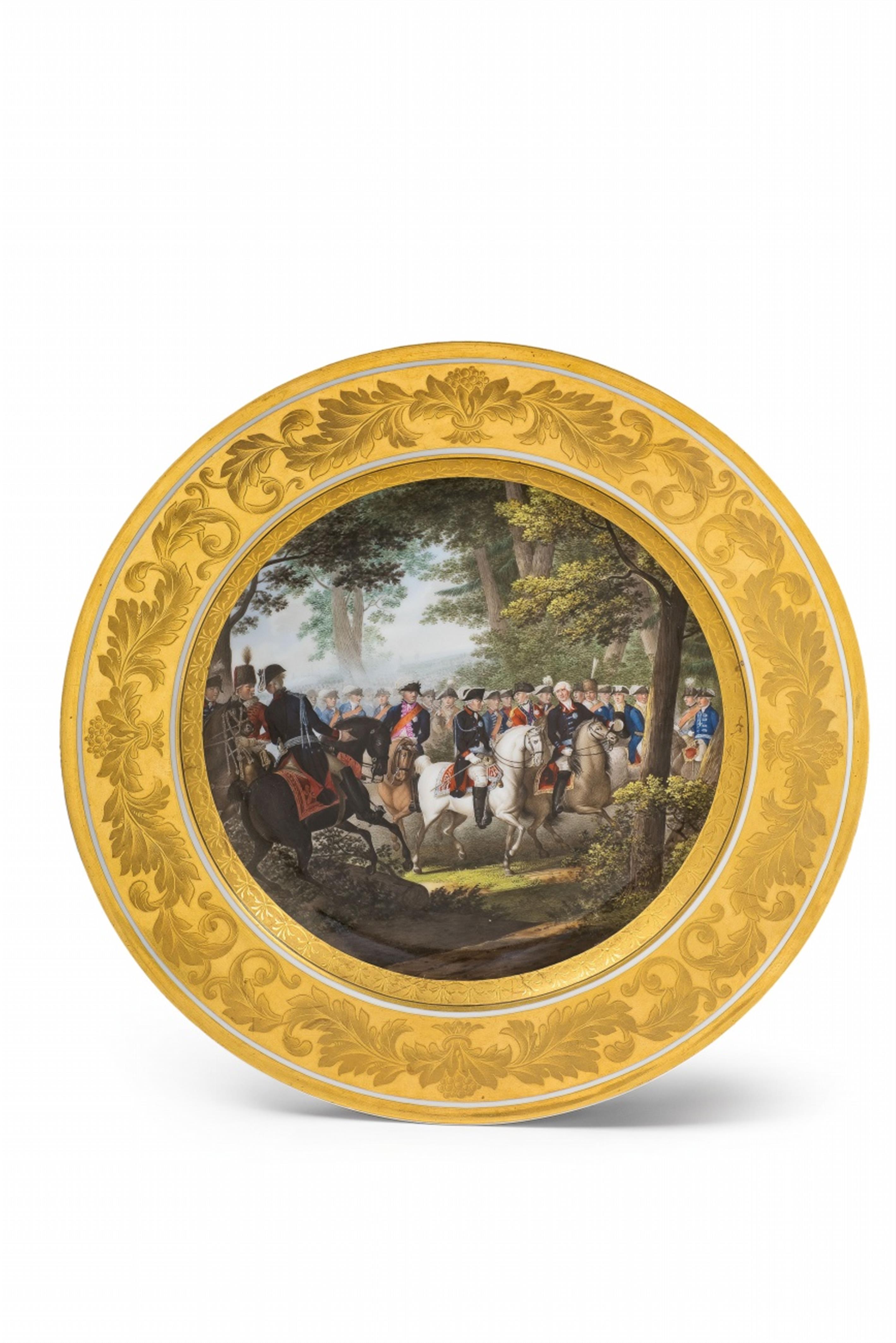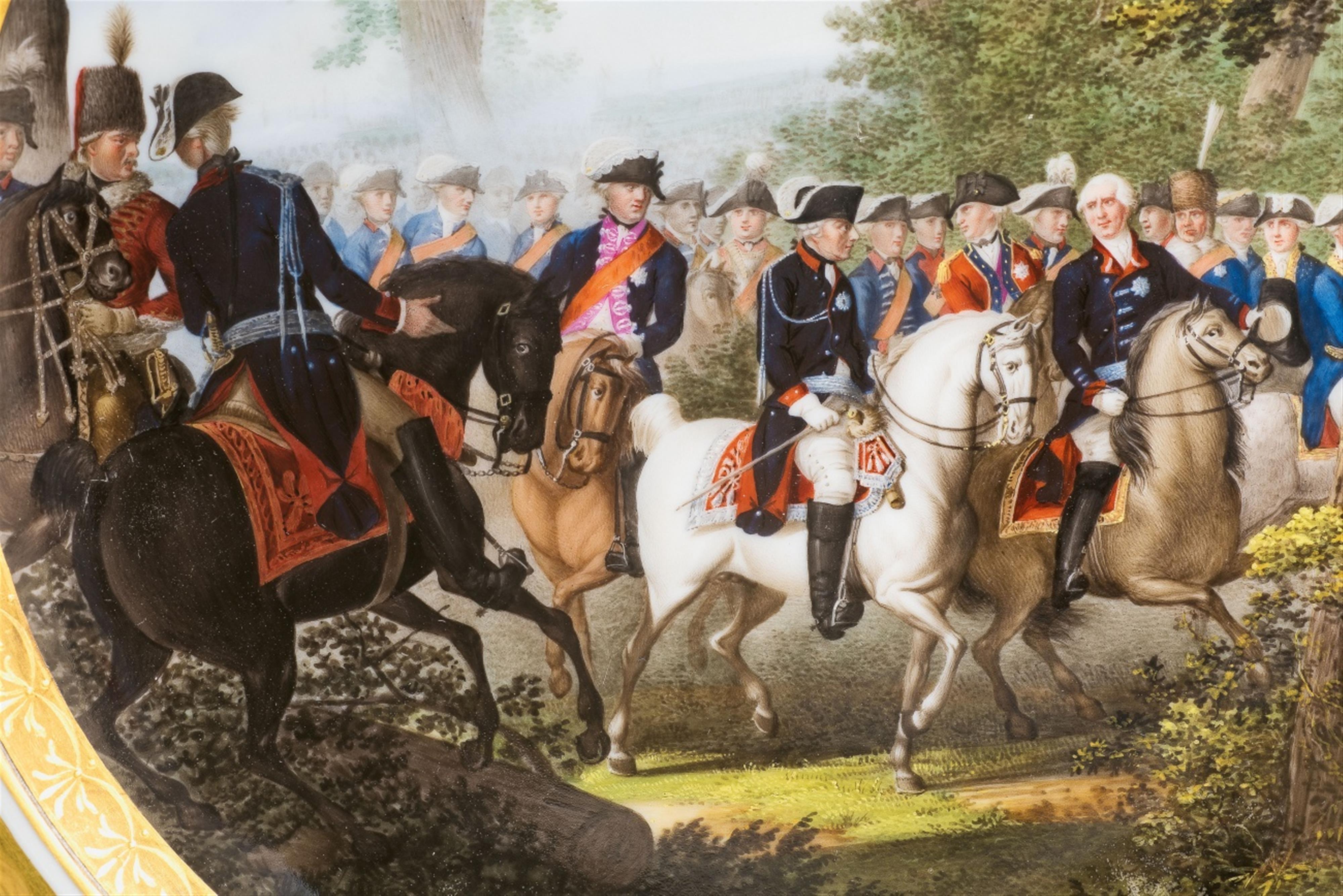A Berlin KPM porcelain plate with the Prussian King returning from a manoeuvre Teller mit der Rückkehr des preußischen Königs vom Manöver
Model no. 1054. Decorated to the centre with a military scene, the cavetto with anthemion motifs and bordered by Neoclassical tendrils. Blue sceptre mark with red dash below, brown F, impressed 22, incised III, black owner's monogram E.A.F.C. for Ernst August Fidei Commis. D 24.7 cm.
1820, after a motif by Edward Francis Cunningham.
"This display plate is an outstanding example of the virtuoso skills with which KPM artists copied original paintings onto porcelain. The technique used to an exceptionally high level at the Sèvres manufactory to reproduce paintings on porcelain while maintaining the quality of the original attracted attention in Berlin and led to attempts to match the skill of the French. The requirements for painting of this kind included not only academic training of the painting staff but also a kind of technique close to oil painting that necessarily required technical innovations such as the development of new colors and porcelain pastes. The plate shown here is from an intermediate stage in this development process. Whereas in stylistic terms it is close to the battle and scenic paintings of the large “Feldherren” services produced in honor of Prussia's generals between 1815 and 1820, it does in fact surpass them in its painterly qualities, such as the highly effective manner in which different values of color and light are distributed.
The subject depicted is derived from a history painting by the English portrait painter Edward Francis Cunningham on the occasion of a visit by the Duke of York, the son of King George III, to Berlin in 1784. The commission, issued to the painter from the English side, envisaged the creation of a large painting that could be reproduced as a copperplate engraving. The reproduction of the original painting was entrusted to the engraver Johan Frederik Clemens (1749 - 1831). As part of the process Cunningham made two oil paintings of the same dimensions which, using slight variations in the composition, depict Frederick II (the Great) surrounded by Prussian princes and generals in the presence of the Duke of York; it was ultimately a third version that served as the model for the engraving. The porcelain painting uses a slightly reduced form of the composition in the engraving. By cutting off the right-hand edge of the engraving and introducing trees in the foreground on the same side, the painter elegantly adapts the horizontal rectangular format of the picture to the circular well of the plate. Through the delicacy of the brushwork, the variations in the shades of color, and the reproduction of a hazy day the porcelain depiction imitates the qualities and characteristics of an oil painting: This effect is additionally heightened by a broad, elaborately engraved gold ledge which emphasizes the resemblance of the miniature image to a painting.
The arabesque border on the ledge is related to the decorative pattern on a dessert plate designed for the Wellington Service, on which, apart from slight differences in the form of the tendrils, the leaf ornament employed is almost identical with that used here. Through its allusion to the best known of all the Berlin “Feldherren” services, this ornament gives the historic image used on the plate a topical reference and thus moves the eighteenth-century image on into the thematic context of the Wars of Liberation. If the Cunningham painting was a record of a historic event that served to commemorate and honor a state visit to Prussia by a member of the English royal family, then hindsight gave this historic moment additional meaning once the Wars of Liberation had been won. The historic reference made by the image invokes the political alliance between the two European states that dates back to the eighteenth century and that, due to the connection of the two royal families over several generations, had continued during the Napoleonic occupation. Through the person of Frederick II, who forms the central figure in the composition, the honor paid to the English ally is connected with another political statement: the depiction of the King who established Prussia as a European power is also a clear statement of national pride and of the revived self-confidence of a Prussia that was now looking to a future in which England and Prussia would be allies of equal standing.
This royal gift is an illuminating example of princely diplomacy. Symbolically connecting history with current politics, it mediates between the donor and the recipient. The latter was the court of Hanover, linked with England through the personal union of their ruling houses: George III was king both of England and of Hanover. The royal house of Hanover was the plate's last owner.” (p. 426ff)
We would like to thank Dr. Samuel Wittwer for kindly allowing us to print this extract from the catalogue "Refinement & Elegance".
Provenance
Sotheby´s Royal House of Hanover Sale, 9th October 2005, lot 238.
Literature
Wittwer (ed.), Raffinesse & Eleganz, Munich 2007, no. 147.
Exhibitions
Raffinesse & Eleganz - Königliche Porzellane des frühen 19. Jahrhunderts aus einer amerikanischen Privatsammlung, Berlin, Stiftung Preußische Schlösser und Gärten, Schloss Charlottenburg, 28th July - 4th November 2007
Die Sammlung Cohen. Porzellane der grossen Manufakturen 1800 - 1840. Wien, Liechtenstein Museum, 16th November 2007 - 11th February 2008
Refinement & Elegance - Early 19th-Century Royal Porcelain from an American private collection, New York, The Metropolitan Museum of Art, 9th September 2008 - 19th April 2009




